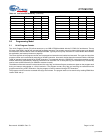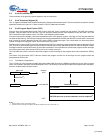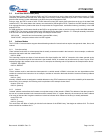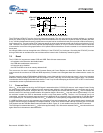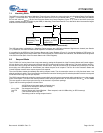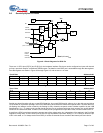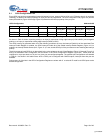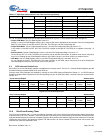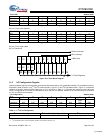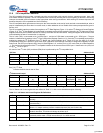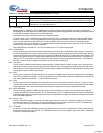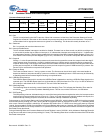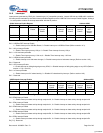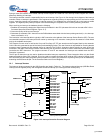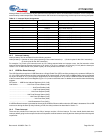
CY7C65113C
Document #: 38-08002 Rev. *D Page 19 of 49
Q1, Q2, and Q3 discussed below are the transistors referenced in Figure 9-1. The available GPIO drive strength are:
• Output LOW Mode: The pin’s Data Register is set to ‘0.’
Writing ‘0’ to the pin’s Data Register puts the pin in output LOW mode, regardless of the contents of the Port Configuration
Bits[1:0]. In this mode, Q1 and Q2 are OFF. Q3 is ON. The GPIO pin is driven LOW through Q3.
• Output HIGH Mode: The pin’s Data Register is set to 1 and the Port Configuration Bits[1:0] is set to ‘10.’
In this mode, Q1 and Q3 are OFF. Q2 is ON. The GPIO is pulled up through Q2. The GPIO pin is capable of sourcing... of
current.
• Resistive Mode: The pin’s Data Register is set to 1 and the Port Configuration Bits[1:0] is set to ‘11.’
Q2 and Q3 are OFF. Q1 is ON. The GPIO pin is pulled up with an internal 14kΩ resistor. In resistive mode, the pin may serve
as an input. Reading the pin’s Data Register returns a logic HIGH if the pin is not driven LOW by an external source.
• Hi-Z Mode: The pin’s Data Register is set to1 and Port Configuration Bits[1:0] is set either ‘00’ or ‘01.’
Q1, Q2, and Q3 are all OFF. The GPIO pin is not driven internally. In this mode, the pin may serve as an input. Reading the
Port Data Register returns the actual logic value on the port pins.
9.2 GPIO Interrupt Enable Ports
Each GPIO pin can be individually enabled or disabled as an interrupt source. The Port 0–1 Interrupt Enable Registers provide
this feature with an Interrupt Enable bit for each GPIO pin.
During a reset, GPIO interrupts are disabled by clearing all of the GPIO Interrupt Enable bits. Writing a ‘1’ to a GPIO Interrupt
Enable bit enables GPIO interrupts from the corresponding input pin. All GPIO pins share a common interrupt, as discussed in
Section 14.7.
.
10.0 12-bit Free-Running Timer
The 12-bit timer operates with a 1-µs tick, provides two interrupts (128 µs and 1.024 ms) and allows the firmware to directly time
events that are up to 4 ms in duration. The lower eight bits of the timer can be read directly by the firmware. Reading the lower
eight bits latches the upper four bits into a temporary register. When the firmware reads the upper four bits of the timer, it is actually
reading the count stored in the temporary register. The effect of this is to ensure a stable 12-bit timer value can be read, even
when the two reads are separated in time.
Table 9-1. GPIO Port Output Control Truth Table and Interrupt Polarity
Port Config Bit 1 Port Config Bit 0 Data Register Output Drive Strength Interrupt Enable Bit Interrupt Polarity
1 1 0 Output LOW 0 Disabled
1 Resistive 1 – (Falling Edge)
1 0 0 Output LOW 0 Disabled
1 Output HIGH 1 Disabled
0 1 0 Output LOW 0 Disabled
1 Hi-Z 1 – (Falling Edge)
0 0 0 Output LOW 0 Disabled
1 Hi-Z 1 + (Rising Edge)
Port 0 Interrupt Enable Address 0x04
Bit # 76543210
Bit Name P0.7 Intr
Enable
P0.6 Intr
Enable
P0.5 Intr
Enable
P0.4 Intr
Enable
P0.3 Intr
Enable
P0.2 Intr
Enable
P0.1 Intr
Enable
P0.0 Intr
Enable
Read/WriteWWWWWWWW
Reset 00000000
Figure 9-5. Port 0 Interrupt Enable
Port 1 Interrupt Enable Address 0x05
Bit # 76543210
Bit Name Reserved Reserved Reserved Reserved Reserved P0.2 Intr
Enable
P1.1 Intr
Enable
P1.0 Intr
Enable
Read/Write-----WWW
Reset -----000
Figure 9-6. Port 1 Interrupt Enable
[+] Feedback



